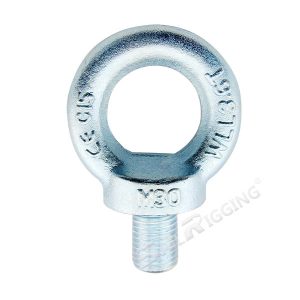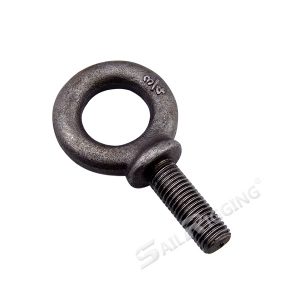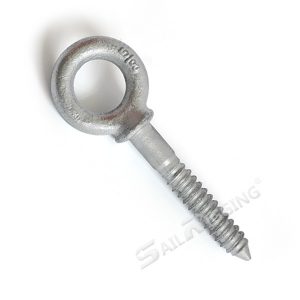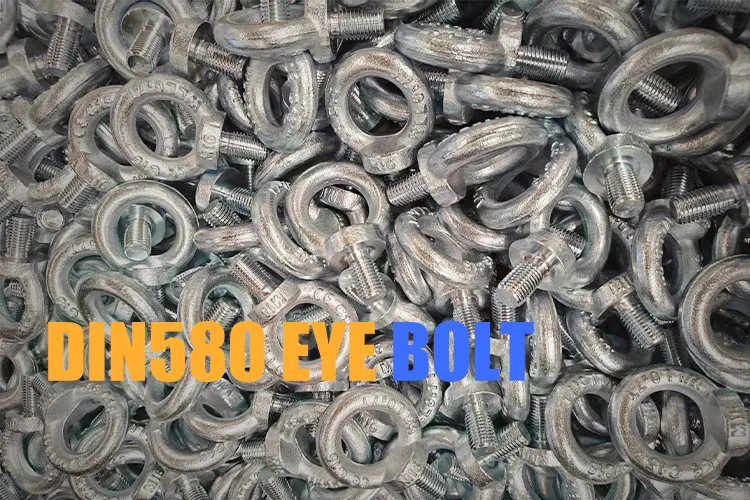An eye bolt, one of the most important pieces of lifting hardware, is a bolt or fastener with a threaded shank on one end and a ring on the other. Do you know when is the first patent for an eyebolt? It was filed in 1891, but the current design wasn’t approved until 1989. Today we’ll cover common types of eyebolts, how to check the size of an eyebolt, the difference between eyebolt and eyenut.
Table of Contents
Common Types of Eye Bolts
There are several types of eye bolts, each designed to perform a specific task.
Forged Eye Bolts
Hammered to form, these eye bolts alter the metal’s grain structure, making them stronger and more durable, making them suitable for heavy-duty lifting applications. Typical examples include DIN 580 eye bolts, which can withstand loads up to the tensile strength of the material and are available in a wide variety of sizes.

Shouldered Eye Bolts
Shouldered eye bolts, such as American-style G277 and G279 eye bolts, feature a shoulder at the junction of the bolt hole and the shank. This reduces bending stress on the shank and allows for tilted lifting. If the shoulder is properly secured to the load, the eye bolt can be used for angled lifting.

Bent Eye Bolts
Bent eye bolts, also known as turned eye bolts or wire eye bolts, are made from a single piece of material that is bent and shaped to form the eye. Bent eye bolts are primarily used for light-duty applications and should not be used for heavy loads, which can cause the eye to open, or for angular loads, which can cause the bolt to bend or break.
Screw Eye bolts
Eyebolts are essentially screws with an eye, such as the American G275 eyebolt, also commonly known as a tension eye. They have an eye on one end and a tapering threaded shank. They are primarily used for light-duty applications, screwing into wood or tension anchors. Eyebolts have no working load limit and are not recommended for overhead lifts or heavy loads.

How to Check Eyebolt Size?
We typically measure eyebolt size using calipers and inch or metric bolt gauges. When measuring eyebolts, it’s important to consider the following: working load limit, thread size, shank length, collar diameter, lifting angle, mating components, and application environment. These factors determine the strength and usability of the bolt. Shaft length and diameter affect bolt strength, while collar diameter affects collar thickness and the material it can pass through. The total length of the bolt from one end to the other is:
Measure the bolt diameter
Using a bolt gauge, pass the bolt through the corresponding size on the gauge, ensuring it fully engages the correct thread gauge. If the two threads are not fully connected or not fully connected, try different sizes until you find one that solves both problems.
Measure the length and eye diameter
Use a caliper to measure the length from the bottom of the eye to the end of the shank and the bolt diameter. These are the two most important measurements because they directly affect the working load limit of the bolt. Measuring the eye diameter allows us to determine its thickness and the material that can pass through the eye (be sure to measure the inside and outside diameters).
Measure the overall length of the bolt
Use a caliper to measure the length from the top of the eye to the bottom of the shank.
What is the difference between an eye nut and an eye bolt?
Eyebolts vs. Eyenuts: As common lifting points, both eyebolts and eyenuts can handle significant loads in terms of strength and load-bearing capacity. However, their load-bearing capacity depends on a variety of factors, including material, size, and installation method. However, there are some differences in application, design, and installation methods. The following is a summary of the differences between eyenuts and eyebolts.
| Eye Bolt | Eye Nut | |
| Application | Eyebolts screw directly into threaded holes or are used with separate nuts to create permanent or semi-permanent lifting points. They are ideal when a dedicated connection point is required in a structure or component. | Lifting eye nuts are designed to thread onto existing bolts or threaded rod, converting standard fasteners into lifting points. This makes them ideal for applications requiring additional lifting capacity to existing bolt assemblies or for threaded rod installations. |
| Design | With a threaded shaft, the eye is an integral part of the fastener head. The threads typically extend along the entire length of the shaft to accommodate varying installation depths. The eye is permanently attached and aligned with the bolt axis. | Eye nuts have a threaded hole that is externally threaded, with an eye extending outward from the body of the nut. The eye can usually be adjusted in direction by rotating the nut, providing some flexibility in positioning the connection point. |
| Installation
|
Thread the eyebolt into the pre-tapped hole or use it in combination with a separate nut and bolt. The installation depth can be adjusted by how far the bolt is screwed into place. Proper installation requires ensuring sufficient thread engagement and achieving the appropriate torque specifications. | Thread the eye nut onto the existing bolt or threaded rod and secure with the appropriate torque. During installation, the eye direction can be adjusted by controlling the final position of the nut. |
Understanding the types of eyebolts, how to measure them, and the differences between eyenuts and bolts will help you choose the right fastener for your specific application. Yunfan Rigging has 16 years of experience in rigging production and manufacturing and is ready to assist you with any questions you may have, providing the best solutions for your lifting and hoisting needs, making your lifting and rigging safer and more reliable.





